
The avifauna of Dominica, a Caribbean island nation, included a total of 197 species according to Bird Checklists of the World as of July 2022.[1] Of them, two are endemic, six have been introduced by humans, and 120 are rare or accidental. One species has been extirpated.
This list is presented in the taxonomic sequence of the Check-list of North and Middle American Birds, 7th edition through the 63rd Supplement, published by the American Ornithological Society (AOS).[2] Common and scientific names are also those of the Check-list, except that the common names of families are from the Clements taxonomy because the AOS list does not include them.
The following tags have been used to highlight several categories of occurrence.
- (A) Accidental - a species that rarely or accidentally occurs in Dominica
- (E) Endemic - a species endemic to Dominica
- (I) Introduced - a species introduced by humans either directly to Dominica or elsewhere in the New World
- (Ex) Extirpated - a species that no longer occurs in Dominica although populations exist elsewhere
Ducks, geese, and waterfowl
Order: Anseriformes Family: Anatidae
Anatidae includes the ducks and most duck-like waterfowl, such as geese and swans. These birds are adapted to an aquatic existence with webbed feet, flattened bills, and feathers that are excellent at shedding water due to an oily coating.
- Black-bellied whistling-duck, Dendrocygna autumnalis (A)
- West Indian whistling-duck, Dendrocygna arborea (A)
- Fulvous whistling-duck, Dendrocygna bicolor (A)
- Muscovy duck, Cairina moschata (A)
- Blue-winged teal, Spatula discors (A)
- Northern shoveler, Spatula clypeata (A)
- American wigeon, Mareca americana (A)
- Green-winged teal, Anas carolinensis
- Ring-necked duck, Aythya collaris (A)
- Lesser scaup, Aythya affinis (A)
- Masked duck, Nomonyx dominicus (A)
Grebes
Order: Podicipediformes Family: Podicipedidae
Grebes are small to medium-large freshwater diving birds. They have lobed toes and are excellent swimmers and divers. However, they have their feet placed far back on the body, making them quite ungainly on land.
- Least grebe, Tachybaptus dominicus (A)
- Pied-billed grebe, Podilymbus podiceps (A)
Pigeons and doves
Order: Columbiformes Family: Columbidae
Pigeons and doves are stout-bodied birds with short necks and short slender bills with a fleshy cere.
- Rock pigeon, Columba livia (I)
- Scaly-naped pigeon, Patagioenas squamosa
- White-crowned pigeon, Patagioenas leucocephala (A)
- African collared-dove, Streptopelia roseogrisea (I)
- Eurasian collared-dove, Streptopelia decaocto (I) (A)
- Common ground dove, Columbina passerina
- Ruddy quail-dove, Geotrygon montana
- Bridled quail-dove, Geotrygon mystacea (A)
- White-winged dove, Zenaida asiatica (A)
- Zenaida dove, Zenaida aurita
Cuckoos
Order: Cuculiformes Family: Cuculidae
The family Cuculidae includes cuckoos, roadrunners, and anis. These birds are of variable size with slender bodies, long tails, and strong legs. The Old World cuckoos are brood parasites.
- Smooth-billed ani, Crotophaga ani
- Yellow-billed cuckoo, Coccyzus americanus (A)
- Mangrove cuckoo, Coccyzus minor
- Black-billed cuckoo, Coccyzus erythropthalmus (A)
Nightjars and allies
Order: Caprimulgiformes Family: Caprimulgidae
Nightjars are medium-sized nocturnal birds that usually nest on the ground. They have long wings, short legs, and very short bills. Most have small feet, of little use for walking, and long pointed wings. Their soft plumage is camouflaged to resemble bark or leaves.
- Common nighthawk, Chordeiles minor
- Antillean nighthawk, Chordeiles gundlachii (A)
- White-tailed nightjar, Hydropsalis cayennensis
Swifts
Order: Apodiformes Family: Apodidae
Swifts are small birds which spend the majority of their lives flying. These birds have very short legs and never settle voluntarily on the ground, perching instead only on vertical surfaces. Many swifts have long swept-back wings which resemble a crescent or boomerang.
- Black swift, Cypseloides niger
- Chimney swift, Chaetura pelagica (A)
- Lesser Antillean swift, Chaetura martinica
Hummingbirds
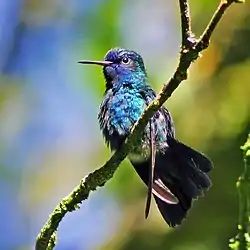
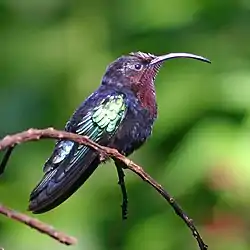
Order: Apodiformes Family: Trochilidae
Hummingbirds are small birds capable of hovering in mid-air due to the rapid flapping of their wings. They are the only birds that can fly backwards.
- Purple-throated carib, Eulampis jugularis
- Green-throated carib, Eulampis holosericeus
- Blue-headed hummingbird, Cyanophaia bicolor
- Antillean crested hummingbird, Orthorhyncus cristatus
Rails, gallinules, and coots
Order: Gruiformes Family: Rallidae
Rallidae is a large family of small to medium-sized birds which includes the rails, crakes, coots, and gallinules. Typically they inhabit dense vegetation in damp environments near lakes, swamps, or rivers. In general they are shy and secretive birds, making them difficult to observe. Most species have strong legs and long toes which are well adapted to soft uneven surfaces. They tend to have short, rounded wings and to be weak fliers.
- Sora, Porzana carolina (A)
- Common gallinule, Gallinula galeata (A)
- American coot, Fulica americana (A)
- Purple gallinule, Porphyrio martinica (A)
Stilts and avocets
Order: Charadriiformes Family: Recurvirostridae
Recurvirostridae is a family of large wading birds which includes the avocets and stilts. The avocets have long legs and long up-curved bills. The stilts have extremely long legs and long, thin, straight bills.
- Black-necked stilt, Himantopus mexicanus
Oystercatchers
Order: Charadriiformes Family: Haematopodidae
The oystercatchers are large, obvious, and noisy plover-like birds, with strong bills used for smashing or prying open molluscs.
- American oystercatcher, Haematopus palliatus (A)
Plovers and lapwings
Order: Charadriiformes Family: Charadriidae
The family Charadriidae includes the plovers, dotterels, and lapwings. They are small to medium-sized birds with compact bodies, short thick necks, and long, usually pointed, wings. They are found in open country worldwide, mostly in habitats near water.
- Black-bellied plover, Pluvialis squatarola (A)
- American golden-plover, Pluvialis dominica (A)
- Killdeer, Charadrius vociferus (A)
- Semipalmated plover, Charadrius semipalmatus (A)
- Wilson's plover, Charadrius wilsonia
Sandpipers and allies
Order: Charadriiformes Family: Scolopacidae
Scolopacidae is a large diverse family of small to medium-sized shorebirds including the sandpipers, curlews, godwits, shanks, tattlers, woodcocks, snipes, dowitchers, and phalaropes. The majority of these species eat small invertebrates picked out of the mud or soil. Variation in length of legs and bills enables multiple species to feed in the same habitat, particularly on the coast, without direct competition for food.
- Upland sandpiper, Bartramia longicauda (A)
- Whimbrel, Numenius phaeopus
- Hudsonian godwit, Limosa haemastica (A)
- Ruddy turnstone, Arenaria interpres (A)
- Red knot, Calidris canutus (A)
- Stilt sandpiper, Calidris himantopus (A)
- Curlew sandpiper, Calidris ferruginea (A)
- Sanderling, Calidris alba (A)
- Dunlin, Calidris alpina (A)
- Baird's sandpiper, Calidris bairdii (A)
- Least sandpiper, Calidris minutilla (A)
- White-rumped sandpiper, Calidris fuscicollis (A)
- Pectoral sandpiper, Calidris melanotos (A)
- Semipalmated sandpiper, Calidris pusilla
- Western sandpiper, Calidris mauri (A)
- Short-billed dowitcher, Limnodromus griseus (A)
- Wilson's snipe, Gallinago delicata (A)
- Spotted sandpiper, Actitis macularia
- Solitary sandpiper, Tringa solitaria
- Lesser yellowlegs, Tringa flavipes
- Willet, Tringa semipalmata (A)
- Greater yellowlegs, Tringa melanoleuca (A)
Skuas and jaegers
Order: Charadriiformes Family: Stercorariidae
The family Stercorariidae are, in general, medium to large birds, typically with grey or brown plumage, often with white markings on the wings. They nest on the ground in temperate and arctic regions and are long-distance migrants.
- Great skua, Stercorarius skua (A)
- South polar skua, Stercorarius maccormicki (A)
- Pomarine jaeger, Stercorarius pomarinus (A)
- Parasitic jaeger, Stercorarius parasiticus (A)
- Long-tailed jaeger, Stercorarius longicaudus (A)
Gulls, terns, and skimmers
Order: Charadriiformes Family: Laridae
Laridae is a family of medium to large seabirds and includes gulls, kittiwakes, terns, and skimmers. They are typically grey or white, often with black markings on the head or wings. They have longish bills and webbed feet. Terns are a group of generally medium to large seabirds typically with grey or white plumage, often with black markings on the head. Most terns hunt fish by diving but some pick insects off the surface of fresh water. Terns are generally long-lived birds, with several species known to live in excess of 30 years.
- Sabine's gull, Xema sabini
- Laughing gull, Leucophaeus atricilla
- Franklin's gull, Leucophaeus pipixcan (A)
- Ring-billed gull, Larus delawarensis (A)
- Herring gull, Larus argentatus
- Lesser black-backed gull, Larus fuscus (A)
- Brown noddy, Anous stolidus (A)
- Sooty tern, Onychoprion fuscata (A)
- Bridled tern, Onychoprion anaethetus (A)
- Least tern, Sternula antillarum (A)
- Gull-billed tern, Gelochelidon nilotica (A)
- Caspian tern, Hydroprogne caspia (A)
- Black tern, Chlidonias niger (A)
- Roseate tern, Sterna dougallii (A)
- Common tern, Sterna hirundo (A)
- Royal tern, Thalasseus maxima
- Sandwich tern, Thalasseus sandvicensis (A)
Tropicbirds
Order: Phaethontiformes Family: Phaethontidae
Tropicbirds are slender white birds of tropical oceans with exceptionally long central tail feathers. Their heads and long wings have black markings.
- White-tailed tropicbird, Phaethon lepturus (A)
- Red-billed tropicbird, Phaethon aethereus (A)
Southern storm-petrels
Order: Procellariiformes Family: Oceanitidae
The storm-petrels are the smallest seabirds, relatives of the petrels, feeding on planktonic crustaceans and small fish picked from the surface, typically while hovering. The flight is fluttering and sometimes bat-like. Until 2018, this family's species were included with the other storm-petrels in family Hydrobatidae.
- Wilson's storm-petrel, Oceanites oceanicus
Northern storm-petrels
Order: Procellariiformes Family: Hydrobatidae
Though the members of this family are similar in many respects to the southern storm-petrels, including their general appearance and habits, there are enough genetic differences to warrant their placement in a separate family.
- Leach's storm-petrel, Hydrobates leucorhous
Shearwaters and petrels
Order: Procellariiformes Family: Procellariidae
The procellariids are the main group of medium-sized "true petrels", characterised by united nostrils with medium septum and a long outer functional primary.
- Black-capped petrel, Pterodroma hasitata (Ex)
- Bulwer's petrel, Bulweria bulwerii (A)
- Cory's shearwater, Calonectris diomedea (A)
- Great shearwater, Ardenna gravis (A)
- Manx shearwater, Puffinus puffinus (A)
- Audubon's shearwater, Puffinus lherminieri (A)
Storks
Order: Ciconiiformes Family: Ciconiidae
Storks are large, long-legged, long-necked, wading birds with long, stout bills. Storks are mute, but bill-clattering is an important mode of communication at the nest. Their nests can be large and may be reused for many years. Many species are migratory.
- Wood stork, Mycteria americana
Frigatebirds
Order: Suliformes Family: Fregatidae
Frigatebirds are large seabirds usually found over tropical oceans. They are large, black-and-white, or completely black, with long wings and deeply forked tails. The males have coloured inflatable throat pouches. They do not swim or walk and cannot take off from a flat surface. Having the largest wingspan-to-body-weight ratio of any bird, they are essentially aerial, able to stay aloft for more than a week.
- Magnificent frigatebird, Fregata magnificens
Boobies and gannets
Order: Suliformes Family: Sulidae
The sulids comprise the gannets and boobies. Both groups are medium to large coastal seabirds that plunge-dive for fish.
- Masked booby, Sula dactylatra (A)
- Brown booby, Sula leucogaster
- Red-footed booby, Sula sula (A)
Cormorants and shags
Order: Suliformes Family: Phalacrocoracidae
Phalacrocoracidae is a family of medium to large coastal, fish-eating seabirds that includes cormorants and shags. Plumage colouration varies, with the majority having mainly dark plumage, some species being black-and-white, and a few being colourful.
- Neotropic cormorant, Nannopterum brasilianum (A)
Pelicans
Order: Pelecaniformes Family: Pelecanidae
Pelicans are large water birds with a distinctive pouch under their beak. As with other members of the order Pelecaniformes, they have webbed feet with four toes.
- Brown pelican, Pelecanus occidentalis (A)
Herons, egrets, and bitterns
Order: Pelecaniformes Family: Ardeidae
The family Ardeidae contains the bitterns, herons, and egrets. Herons and egrets are medium to large wading birds with long necks and legs. Bitterns tend to be shorter necked and more wary. Members of Ardeidae fly with their necks retracted, unlike other long-necked birds such as storks, ibises, and spoonbills.
- Least bittern, Ixobrychus exilis (A)
- Great blue heron, Ardea herodias (A)
- Great egret, Ardea alba
- Little egret, Egretta garzetta (A)
- Snowy egret, Egretta thula (A)
- Little blue heron, Egretta caerulea
- Tricolored heron, Egretta tricolor (A)
- Reddish egret, Egretta rufescens (A)
- Cattle egret, Bubulcus ibis
- Green heron, Butorides virescens
- Black-crowned night-heron, Nycticorax nycticorax (A)
- Yellow-crowned night-heron, Nyctanassa violacea (A)
Ibises and spoonbills
Order: Pelecaniformes Family: Threskiornithidae
Threskiornithidae is a family of large terrestrial and wading birds which includes the ibises and spoonbills. They have long, broad wings with 11 primary and about 20 secondary feathers. They are strong fliers and despite their size and weight, very capable soarers.
- White ibis, Eudocimus albus (A)
- Scarlet ibis, Eudocimus ruber (A)
- Glossy ibis, Plegadis falcinellus (A)
Osprey
Order: Accipitriformes Family: Pandionidae
The family Pandionidae contains only one species, the osprey. The osprey is a medium-large raptor which is a specialist fish-eater with a worldwide distribution.
- Osprey, Pandion haliaetus (A)
Hawks, eagles, and kites
Order: Accipitriformes Family: Accipitridae
Accipitridae is a family of birds of prey, which includes hawks, eagles, kites, harriers, and Old World vultures. These birds have powerful hooked beaks for tearing flesh from their prey, strong legs, powerful talons, and keen eyesight.
- Northern harrier, Circus hudsonius (A)
- Black kite, Milvus migrans (A)
- Broad-winged hawk, Buteo platypterus
Barn-owls
Order: Strigiformes Family: Tytonidae
Barn-owls are medium to large owls with large heads and characteristic heart-shaped faces. They have long strong legs with powerful talons.
- Barn owl, Tyto alba
Kingfishers
Order: Coraciiformes Family: Alcedinidae
Kingfishers are medium-sized birds with large heads, long, pointed bills, short legs, and stubby tails.
- Ringed kingfisher, Megaceryle torquatus
- Belted kingfisher, Megaceryle alcyon (A)
Woodpeckers
Order: Piciformes Family: Picidae
Woodpeckers are small to medium-sized birds with chisel-like beaks, short legs, stiff tails, and long tongues used for capturing insects. Some species have feet with two toes pointing forward and two backward, while several species have only three toes. Many woodpeckers have the habit of tapping noisily on tree trunks with their beaks.
- Yellow-bellied sapsucker, Sphyrapicus varius (A)
Falcons and caracaras
Order: Falconiformes Family: Falconidae
Falconidae is a family of diurnal birds of prey. They differ from hawks, eagles, and kites in that they kill with their beaks instead of their talons.
- American kestrel, Falco sparverius
- Merlin, Falco columbarius (A)
- Peregrine falcon, Falco peregrinus
New World and African parrots
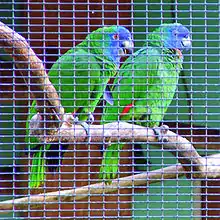
Order: Psittaciformes Family: Psittacidae
Parrots are small to large birds with a characteristic curved beak. Their upper mandibles have slight mobility in the joint with the skull and they have a generally erect stance. All parrots are zygodactyl, having the four toes on each foot placed two at the front and two to the back.
- Brown-throated parakeet, Eupsittula pertinax (I)
- Red-necked parrot, Amazona arausiaca (E)
- Imperial parrot, Amazona imperialis (E)
Tyrant flycatchers

Order: Passeriformes Family: Tyrannidae
Tyrant flycatchers are passerine birds which occur throughout North and South America. They superficially resemble the Old World flycatchers, but are more robust and have stronger bills. They do not have the sophisticated vocal capabilities of the songbirds. Most, but not all, have plain colouring. As the name implies, most are insectivorous.
- Caribbean elaenia, Elaenia martinica
- Lesser Antillean flycatcher, Myiarchus oberi
- Eastern kingbird, Tyrannus tyrannus (A)
- Gray kingbird, Tyrannus dominicensis
- Lesser Antillean pewee, Contopus latirostris
Vireos, shrike-babblers, and erpornis
Order: Passeriformes Family: Vireonidae
The vireos are a group of small to medium-sized passerine birds. They are typically greenish in colour and resemble New World warblers apart from their heavier bills.
- Yellow-throated vireo, Vireo flavifrons (A)
- Black-whiskered vireo, Vireo altiloquus
Swallows
Order: Passeriformes Family: Hirundinidae
The family Hirundinidae is adapted to aerial feeding. They have a slender streamlined body, long pointed wings, and a short bill with a wide gape. The feet are adapted to perching rather than walking, and the front toes are partially joined at the base.
- Bank swallow, Riparia riparia
- Caribbean martin, Progne dominicensis
- Barn swallow, Hirundo rustica
- Cliff swallow, Petrochelidon pyrrhonota (A)
Waxwings
Order: Passeriformes Family: Bombycillidae
The waxwings are a group of birds with soft silky plumage and unique red tips to some of the wing feathers. In the Bohemian and cedar waxwings, these tips look like sealing wax and give the group its name. These are arboreal birds of northern forests. They live on insects in summer and berries in winter.
- Cedar waxwing, Bombycilla cedrorum (A)
Wrens
Order: Passeriformes Family: Troglodytidae
The wrens are mainly small and inconspicuous except for their loud songs. These birds have short wings and thin down-turned bills. Several species often hold their tails upright. All are insectivorous.
- House wren, Troglodytes aedon
Mockingbirds and thrashers

Order: Passeriformes Family: Mimidae
The mimids are a family of passerine birds that includes thrashers, mockingbirds, tremblers, and the New World catbirds. These birds are notable for their vocalizations, especially their ability to mimic a wide variety of birds and other sounds heard outdoors. Their colouring tends towards dull-greys and browns.
- Scaly-breasted thrasher, Allenia fusca
- Pearly-eyed thrasher, Margarops fuscatus
- Brown trembler, Cinclocerthia ruficauda
- Tropical mockingbird, Mimus gilvus
Thrushes and allies
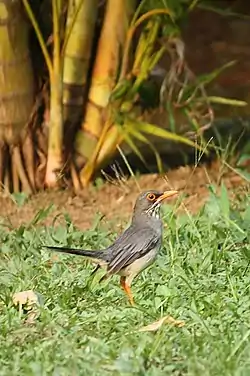
Order: Passeriformes Family: Turdidae
The thrushes are a group of passerine birds that occur mainly in the Old World. They are plump, soft plumaged, small to medium-sized insectivores or sometimes omnivores, often feeding on the ground. Many have attractive songs.
- Rufous-throated solitaire, Myadestes genibarbis
- Spectacled thrush, Turdus nudigenis
- Forest thrush, Turdus lherminieri
- Red-legged thrush, Turdus plumbeus
Waxbills and allies
Order: Passeriformes Family: Estrildidae
The estrildid finches are small passerine birds native to the Old World tropics. They are gregarious and often colonial seed eaters with short thick but pointed bills. They are all similar in structure and habits, but have wide variation in plumage colours and patterns.
- Scaly-breasted munia, Lonchura punctulata (I)
Old World sparrows
Order: Passeriformes Family: Passeridae
Old World sparrows are small passerine birds. In general, sparrows tend to be small plump brownish or greyish birds with short tails and short powerful beaks. Sparrows are seed eaters, but they also consume small insects.
- House sparrow, Passer domesticus (I)
Finches, euphonias, and allies
Order: Passeriformes Family: Fringillidae
Finches are seed-eating passerine birds, that are small to moderately large and have a strong beak, usually conical and in some species very large. All have twelve tail feathers and nine primaries. These birds have a bouncing flight with alternating bouts of flapping and gliding on closed wings, and most sing well.
- Lesser Antillean euphonia, Chlorophonia flavifrons (A)
Troupials and allies
Order: Passeriformes Family: Icteridae
The icterids are a group of small to medium-sized, often colourful, passerine birds restricted to the New World and include the grackles, New World blackbirds, and New World orioles. Most species have black as the predominant plumage colour, often enlivened by yellow, orange, or red.
- Bobolink, Dolichonyx oryzivorus (A)
- Venezuelan troupial, Icterus icterus (A)
- Shiny cowbird, Molothrus bonariensis
- Carib grackle, Quiscalus lugubris
New World warblers
.jpg.webp)
Order: Passeriformes Family: Parulidae
The New World warblers are a group of small, often colourful, passerine birds restricted to the New World. Most are arboreal, but some are terrestrial. Most members of this family are insectivores.
- Ovenbird, Seiurus aurocapilla (A)
- Louisiana waterthrush, Parkesia motacilla (A)
- Northern waterthrush, Parkesia noveboracensis (A)
- Black-and-white warbler, Mniotilta varia
- Prothonotary warbler, Protonotaria citrea (A)
- Mourning warbler, Geothlypis philadelphia (A)
- Kentucky warbler, Geothlypis formosus
- Common yellowthroat, Geothlypis trichas (A)
- Plumbeous warbler, Setophaga plumbea
- Hooded warbler, Setophaga citrina (A)
- American redstart, Setophaga ruticilla (A)
- Cape May warbler, Setophaga tigrina (A)
- Northern parula, Setophaga americana (A)
- Magnolia warbler, Setophaga magnolia (A)
- Bay-breasted warbler, Setophaga castanea (A)
- Blackburnian warbler, Setophaga fusca (A)
- Yellow warbler, Setophaga petechia
- Chestnut-sided warbler, Setophaga pensylvanica (A)
- Blackpoll warbler, Setophaga striata
- Black-throated blue warbler, Setophaga caerulescens (A)
- Palm warbler, Setophaga palmarum (A)
- Yellow-rumped warbler, Setophaga coronata (A)
- Black-throated green warbler, Setophaga virens (A)
Cardinals and allies
Order: Passeriformes Family: Cardinalidae
The cardinals are a family of robust, seed-eating birds with strong bills. They are typically associated with open woodland. The sexes usually have distinct plumages.
- Scarlet tanager, Piranga olivacea (A)
- Rose-breasted grosbeak, Pheucticus ludovicianus (A)
- Indigo bunting, Passerina cyanea (A)
Tanagers and allies
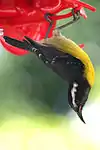
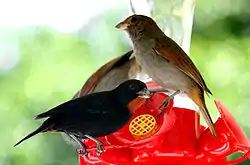
Order: Passeriformes Family: Thraupidae
The tanagers are a large group of small to medium-sized passerine birds restricted to the New World, mainly in the tropics. Many species are brightly coloured. As a family they are omnivorous, but individual species specialize in eating fruits, seeds, insects, or other types of food. Most have short, rounded wings.
- Bananaquit, Coereba flaveola
- Lesser Antillean bullfinch, Loxigilla noctis
- Black-faced grassquit, Melanospiza bicolor
- Lesser Antillean saltator, Saltator albicollis
References
- ↑ Lepage, Denis (March 13, 2021). "Checklist of Birds of Dominica". Avibase bird checklists of the world. Retrieved September 2, 2021.
- ↑ Chesser, R. T., S. M. Billerman, K. J. Burns, C. Cicero, J. L. Dunn, B. E. Hernández-Baños, R. A. Jiménez, A. W. Kratter, N. A. Mason, P. C. Rasmussen, J. V. Remsen, Jr., D. F. Stotz, and K. Winker. 2022. Check-list of North American Birds (online). American Ornithological Society. (July 29, 2022). "Check-list of North and Middle American Birds". American Ornithological Society. Retrieved July 7, 2022.
{{cite web}}: CS1 maint: multiple names: authors list (link) CS1 maint: numeric names: authors list (link)